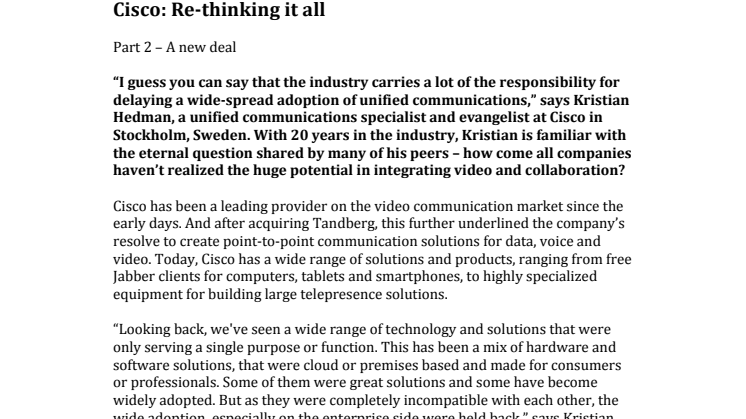News -
Cisco: Re-thinking it all
Part 2 – A new deal
“I guess you can say that the industry carries a lot of the responsibility for delaying a wide-spread adoption of unified communications,” says Kristian Hedman, a unified communications specialist and evangelist at Cisco in Stockholm, Sweden. With 20 years in the industry, Kristian is familiar with the eternal question shared by many of his peers – how come all companies haven’t realized the huge potential in integrating video and collaboration?
Cisco has been a leading provider on the video communication market since the early days. And after acquiring Tandberg, this further underlined the company’s resolve to create point-to-point communication solutions for data, voice and video. Today, Cisco has a wide range of solutions and products, ranging from free Jabber clients for computers, tablets and smartphones, to highly specialized equipment for building large telepresence solutions.
“Looking back, we've seen a wide range of technology and solutions that were only serving a single purpose or function. This has been a mix of hardware and software solutions, that were cloud or premises based and made for consumers or professionals. Some of them were great solutions and some have become widely adopted. But as they were completely incompatible with each other, the wide adoption, especially on the enterprise side were held back,” says Kristian Hedman.
Over the recent years a lot of energy and resources have been spent on trying to tie these communications silos together. As a result of this, a new wave of technology providers introduced a number of different solutions with the promise to "integrate" the silos.
“Unfortunately, we see that these interim solutions are not only doing good. They add a lot of complexity to the customer’s architecture and make them even more messy and difficult to manage. I don’t think it is reasonable that customers should have to patch their solutions together. Going forward, the industry in general is getting more aware of the value of driving their solutions towards common standards and this will make the solutions work together natively.”
Always video
Working with video conferencing has changed how Kristian Hedman regards communications. He says that once you start using video, it really becomes addictive. When his children got themselves iPhones, he introduced them to Facetime so they could make video calls on special occasions. But after a while, Facetime became the default way of communications for his children so now most of their calls are made with video.
At the same time, Kristian says that the Facetime is incompatible with the desktop solutions used in the office. So he sees this as a typical example of how the heterogeneous technology environment is preventing video and UC from becoming pervasive.
“At the same time, it is interesting to see how video changes the way we communicate. When we meet in real life, our communications relies heavily on non-verbal cues. For example, as you are explaining something, you get real-time feedback by looking at the person you are talking to. Having only voice impacts our natural communications by removing those cues, making it much less effective.”
Once video, always video
Kristian also reflects over that his colleagues, who aren’t involved with the video and unified communications part of Cisco, don’t have the same habit of using the technology in their everyday work. But as soon as people start using video, they quickly come to expect to be able to see the person they talk to.
So, what is it that has been holding the development back, and more importantly, how will unified communications become widespread among companies around the world?
“Video solutions are definitely using very advanced and sophisticated technology but I think it’s a mistake to group these solutions together with other IT investments. Visual unified communications is a business enabler and should not be affected by IT budget restrains. Enterprise class video needs to become more accessible for all types of organizations so it can scale. In order to get there, ease of deployment needs to increase and the cost must come down.”
Rethinking the strategy
Relatively recently, Cisco decided to re-think their complete video and unified collaboration offering. Knowing that reaching a critical mass in the number of installations is a requirement for a broader adoption of video communications, Cisco decided to focus on removing the pain points holding the development back.
“We identified a few basic factors, which aren’t really rocket science but still changed our whole approach. We reduced the number of different product families and products, and instead focused on a few. We acknowledged the need to be able to provide solutions for both the low-end and high-end users, and lowered prices substantially for the end points to reduce the initial investment costs.”
With this model, the revenue per sold unit is lower, but the increasing volumes make up for it. Cisco also sees that once an organization gets started with video and realizes its potential for increased productivity and how it generates new business opportunities, they will want to increase the reach and invest more.
What’s next?
Even though some businesses decide to use simpler video conferencing and collaboration solutions, this still means more people realizing how powerful it is. Then the demand for higher quality solutions will increase.
“We are not competing with the free, consumer oriented, alternatives. I see this as good way to get introduced to a new way of working. The more people and organizations realize the potential, the better for the industry as a whole. Once you see what a little bit of video and collaboration can do for your productivity, you will be coming back for the real thing,” says Kristian Hedman.Please discuss on #futureuc
Topics
- Data, Telecom, IT
Categories
- unified communications
- #futureuc
- kristian hedman
- cisco

